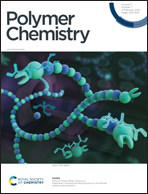Fluorous effect-induced emission of azido substituted poly(vinylidene fluoride) with high photostability and film formation†
Abstract
In this work, we describe the first example of poly(vinylidene fluoride) (PVDF)-based luminescent fluoropolymers (ASFPs) with unconventional azido groups attached as chromophores, which display a strong excitation-dependent emission behaviour in both solution and solid-state. The fluorous effect, which refers to the influence of the strong electron withdrawing effect of neighbouring fluorine atoms on the energy gaps of azido groups and the non-radiative relaxation pathway depression by lower-frequency carbon–fluorine stretching modes, is responsible for the formation of the stable excited state and the retention of high fluorescence efficiency (photoluminescence quantum yields ≥ 10%). The excellent photostability, good solution processability, and independent emission to aggregation of ASFPs allow them to find promising applications as aqueous and oil tolerant fluorescent inks, high mechanical strength films, and multicolour imaging fluorescent nanofibers.



 Please wait while we load your content...
Please wait while we load your content...